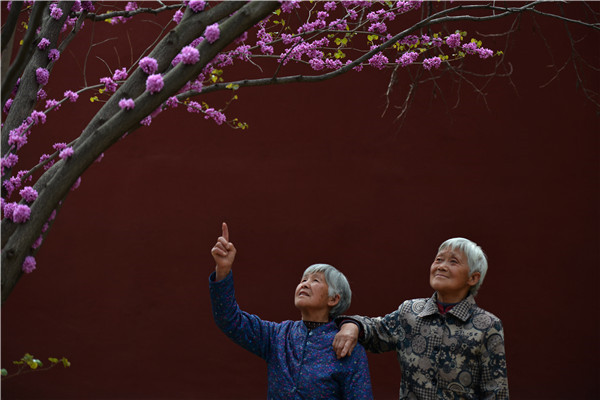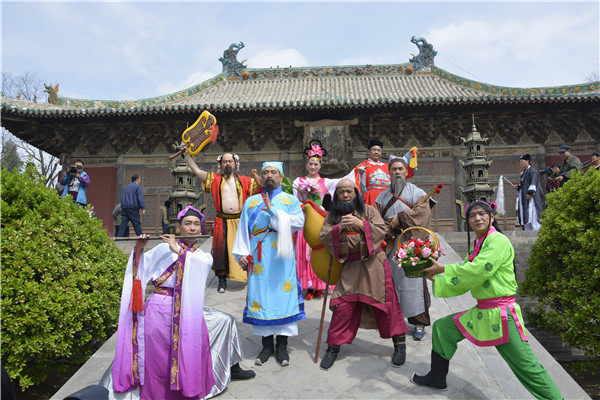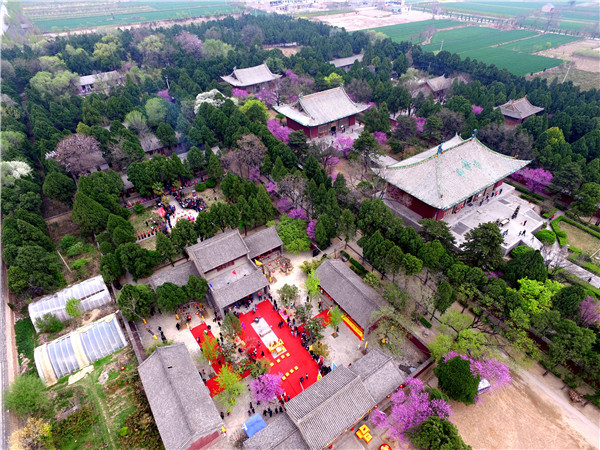
Yongle Palace (palace of eternal joy), one of the three biggest Taoist temples in China, is the largest of all Taoist temples remaining from the Yuan dynasty, and it was built to consolidate political power for the emperors of the Yuan dynasty. The Palace, covering an area of 248,000 square meters, is world-renowned for its architectural art and murals. It is located in the suburb of Ruicheng County, Shanxi Province, about 3 kilometers north of the county center. Endowed with magnificent and fascinating scenery, the Palace is bounded by the mountains in the north and the Yellow River in the south. It is 60 kilometers away from the Temple of Universal Salvation (Pu Jiu Si), the Stork Tower (Guan Que Lou) and the Ferry of Iron Cow (Tie Niu) in Yongji City, 30 kilometers away from the Guangyu Temple (Guang Di Miao) in Yuncheng City, 66 kilometers away from Mount Hua (Hua Shan) and 200 kilometers away from Luoyang City.
Yongle Palace started to be built in 1247 and was completed in 1358. The whole project took 111 years. On March 4, 1961, it was chosen into the first batch of key historical sites under state protection by the State Council. On October 28, 1998, it was listed on the pre-list of world cultural heritage by the UNESCO. In 2001, the State Post Bureau issued the stamps of its murals. In 2004, it was rated as a National AAAA Level Tourist Attraction by the National Tourism Administration. In 2011, it was awarded “one of the top ten most beautiful cultural relics in Shanxi Province”.
The Palace was originally built in Yongle Town, 20 kilometers southwest of Ruicheng County. Yongle Town is the birthplace of Lü Dongbin, the ancestor of Taoism. In the late 1950s when the Sanmenxia Reservoir was being constructed, the Palace was expected to be in the submerged area according to the planning. With the approval and instruction of Premier Zhou, the Ministry of Water Resources allocated 2.2 million RMB for the relocation project of the Palace. From 1959 to 1965, the whole palace with its cultural relics was moved to the Ancient Wei State Site of the Western Zhou Dynasty, 2 kilometers north of the county center. The six-year relocation project and the relocation of Egypt’s Abu Simbel temples were known as “the two miracles of artificial relocation in the world history of cultural relics”.
Yongle Palace preserves four exquisite wooden structures of the Yuan dynasty, which are located on the central axis of 500 meters long. The east-west axis extends through the Temple of Lü Dongbin (Lü Zu Miao), Temple of Wealth (Cai Shen Miao), Temple of Emperor Xuantian (Xuan Di Miao) to the Tomb of Lü Dongbin (Lü Zu Mu). These structures, solemn and serene, are of great importance in the history of Chinese architecture. The most impressive is the 1000-square-meter mural of the Yuan dynasty, distributed in the Longhu Hall, Sanqing Hall, Chunyang Hall and Chongyang Hall. There are many works of different styles such as figures and landscape paintings in gongbi style. Known as the “Oriental Art Gallery”, the mural is one of the existing treasures of ancient mural art, a masterpiece in the history of world art, and a valuable legacy of world culture. Since its opening in 1979, it has become an imitation practice base for major art schools in China.
In the northwest of the Palace sits the Guangrenwang Temple (also known as “Wulong Temple”), one of the four buildings of the Tang dynasty in China; and in the south, there is a Stupa of the Song dynasty. The Palace keeps the 3,000-year-old Wall Relics of the Ancient Wei State. With lush pine and cypresses, loft pavilions, and solemn Taoist temples, the Palace is a sacred place that integrates leisure, entertainment and art appreciation.

[Sanqing Hall]
Sanqing Hall, also referred to as “Wuji Hall”, houses three statues featuring the three most well-known Immortals of Taoism, and it is the main hall of Yongle Palace. Being spectacular and magnificent, Sanqing Hall is the most important building with curved and upturned eaves in the Palace; and the top of the Hall is decorated with yellow, green and blue glazed tiles. It is beautifully colored and uniquely designed. On the ridge of the Hall stand two peacock blue glazed dragons up to 3 meters. The two dragons are so vivid as if they are about to soar into the air, from which we can know that the glazed products at that time attained a level never achieved before. The murals in the Sanqing Hall, collectively known as “Worshiping Yuanshi Heavenly Spirit” (Chao Yuan Tu), show the grand scene of the 290 gods worshiping Yuanshi Heavenly Spirit (Yuan Shi Tian Zun). It is 97 meters long and 4.26 meters high, covering a total area of more than 400 square meters. In the murals, eight main statues are 3 meters high, and the lowest is 1.9 meters, exceeding the height of a real person. The murals were completed in 1325 A.D., nearly 200 years earlier than the European Renaissance. With magnificent layout, fine brushwork and splendid color scheme, the murals represent the essence of ancient murals and the highest achievement of the Taoist murals in the Yuan dynasty. Moreover, as the largest piece of Chinese ancient figure paintings and single murals found so far, it is of great significance in the history of world painting.

[Chunyang Hall]
Chunyang Hall, also known as “Huncheng Hall”, is dedicated to Lü Dongbin, the ancestor of Taoism. The entire hall preserves the architectural style of the Yuan dynasty, quaint and exquisite. The interior of the hall is painted with the murals of 212 square meters, which are collectively called “Fugue Manifest Painting of Chunyang Emperor (Chunyang Di Jun Shen You Xian Hua Tu)”. The murals, recording 52 legendary stories of Lü Dongbin in the style of the green landscape comics, have reproduced the social life at that time and provided us with valuable information and rare illustrations to study the social life of the Song and Yuan dynasties and the Lü culture as well.
[Chongyang Hall]
Chongyang Hall, also known as “Qizhen Hall”, is dedicated to Wang Chongyang, the founder of the Quanzhen Sect of Taoism. The quaint and beautiful hall with simple structure is of great value to the study of the ancient buildings of the Song and Yuan dynasties. The 150-square-meter murals, based on 49 preach stories of Wang Chongyang and his disciples, are regarded as precious materials for studying the social life at that time.

[The Ancestral Temple of Lü Dongbin]
The Ancestral Temple of Lü Dongbin is the house where Lü Dongbin was born and raised. Lü Dongbin was highly respected in his village because of his noble virtues; and after his decease, his fellow villagers went to his house to mourn. Then the emperor changed the house into an ancestral temple called “the Ancestral Temple of Lü Dongbin”. After being burnt down in the Jin dynasty, the ancestral temple was restored in the Jiaqing reign period (1796-1820) and moved to this place in 1959.
Lü Dongbin was a Tang dynasty Chinese scholar, who became a Jinshi (a successful candidate in the highest imperial examinations) when he hit 64. But before taking office, he met a Taoist adept named Zhongli Quan in a spring trip, who enlightened him to adopt the Way of Taoist faith.
Lü Dongbin, as a great medical scientist, health expert and poet in Chinese history, devoted all his life to cultivating both inner self and outer self, developing merits and virtues, and promoting longevity. His two monuments, “Inner Self Cultivation” and “Outer Self Cultivation”, contain many health philosophies, which are widely circulated and still inspire the future generations.
The white marble statue of Lü Dongbin stands in the main hall of the Ancestral Temple of Lü Dongbin, flanked by two 100-character monuments, “Inner Self Cultivation” and “Outer Self Cultivation”. The wing rooms host the relocation exhibition and the exhibition of Lü’s legends and historical materials. After the renovation, the Ancestral Temple of Lü Dongbin has become an old and elegant home temple with beautiful gardens and quaint yards.
In 2006, the Ancestral Temple of Lü Dongbin was approved by the State Bureau of Religious Affairs as a place for Taoist activities. Temple fairs are held in Yongle Palace on the 3rd day of the 3rd lunar month and on the 14th day of the 4th lunar month every year, and the villagers from Shaanxi, Shanxi and Henan provinces will come here to worship Lü Dongbin. They light incense, make wishes and pray, creating a festive and lively atmosphere.

[Imitation Room]
Yongle Palace has 350 square meters of Imitation Room, which is divided into two parts and located on the west axis. The Imitation Room presents the full-scale murals “Worshiping Yuanshi Heavenly Spirit” (Chao Yuan Tu), which originally preserved in the Sanqing Hall, for students to imitate. Since its opening in 1979, it has become a imitation practice base for major art schools in China.
[Stone Arch of Ethics]
The Stone Arch of Ethics, originally in the Nanlijiao Village, Yongle Town, was moved to the east side of Yongle Palace because the Village was in the submerged area of the Yellow River when the Sanmenxia Reservoir was being constructed. The Stone Arch of Ethics was built in memory of Dutiful Son Li Tianren in 1777 (in the 42nd year of the Qianlong reign period in the Qing dynasty). Li Tianren, born in the Lijiao Village, once studied in the Imperial College (Guo Zi Jian). Tianren had a son named “Tengjiao” who was appointed the prefect of Zunhua City and had Grand Secretary Ji Xiaolan as his imperial examination tutor. After the death of Tengjiao, Ji Xiaolan wrote his epitaph. The Stone Arch of Ethics is mainly made up of four pillars and three cornices, with its architrave carved “the Birthday Congratulations of Eight Immortals” (Ba Xian Qing Shou Tu). The six stone lions before and behind the stone pillars are exquisite and lovely. Others decorative patterns and designs with figures, animals, flowers, calligraphy and painting on them also look quaint and exquisite like masterpieces. The Stone Arch of Ethics moved here along with Yongle Palace in 1959 and rebuilt in 1988. It is a popular tourist spot in the Palace.
Address:
No. 78, Yongle North Road, Ruicheng County, Yuncheng City, Shanxi Province
Wechat Official Account: yonglegong2015
Opening Hours:
Slack season: Nov. 1st to Feb. 29th
Peak season: Mar. 1st to Oct. 31st
Ticket Office and Inquiry Hotline:
Office Tel: 0359-3011521
Ticket Center Tel: 0359-3011491
Transportation Guide:
Self-driving Routes:
Xi’an City—Palace of Eternal Joy (Start from Xi’an City and drive into the Lianhuo Expressway; get off the expressway and enter the Fenglingdu Yellow River Bridge; turn left at the end of the Bridge and come onto the Caofeng Line; keep driving for about 1 hour and get to Yongle Palace. The whole journey will cost you about 3 hours.)
Henan Province—Palace of Eternal Joy (Start from Sanmenxia City and come onto the G209 Line; drive northeastward about 1.3 kilometers and then enter the Sanmenxia Yellow River Highway Bridge; drive about 1.4 kilometers along the Bridge and then enter the G209 Line; drive about 446 meters along the G209 Line and turn left into the Caofeng Line; drive about 46.1 kilometers along the Caofeng Line and come onto the S239 Line; drive westward about 1.3 kilometers to the Caofeng Line and drive about 17.6 kilometers along the Caofeng Line and then turn right into the Yongjiu Line; keep driving northward less than 1 kilometer and get to Yongle Palace. The whole journey will cost you about 1 hour and 50 minutes.)
Yuncheng City—Palace of Eternal Joy (Start from Yuncheng City and drive for about 1 hour on the expressway from Yuncheng West/South to Ruicheng East; get out of the Zhongtiao Mountain Tunnel and then turn right into the Caofeng Line; keep driving for about half an hour to get to Yongle Palace. The whole journey will cost you about 1 hour and 30 minutes.)
Bus Routes:
Xi’an City—Palace of Eternal Joy (Take a coach in Xi’an Sanfuwan Bus Terminus to Ruicheng City, which will take you about 2 hours to Ruicheng Bus Station; and then take a taxi from Ruicheng Bus Station to Yongle Palace. The whole journey will cost you about 3 hours.)
Henan Province—Palace of Eternal Joy (Take a coach in Sanmenxia Coach Terminal to Ruicheng City, which will take you about 2 hours and 30 minutes to Ruicheng Bus Station; and then take a taxi from Ruicheng Bus Station to Yongle Palace. The whole journey will cost you about 3 hours.)
Yuncheng City—Palace of Eternal Joy (Take a coach in Yuncheng Central Bus Station to Ruicheng City, which will take you about 1 hour to Ruicheng Bus Station; and then take a taxi from Ruicheng Bus Station to Yongle Palace. The whole journey will cost you about 1 hour and 30 minutes.)
Notes:
Ticket Discounts:
Children under 1.2m in height: free;
Children 1.2m -1.4m in height: 25 RMB per person;
Seniors 60 years old and older with valid proof of age (ID Card or Senior Citizen Card): free;
Military officers, soldiers, the disabled, journalists with valid certificates: free;
Students with valid student I.D.: 50% discount.
Attention:
The admission tickets do not include GUIDED TOUR SERVICES, which charge a group with less than 16 people 55 RMB and a group with more than 16 people 70 RMB.
Travel Tips:
Visitors are mainly attracted by the Yuan dynasty murals and Taoist buildings in Yongle Palace. Photographing in the main hall is prohibited for the good of the murals. Since the interior of the Palace is gloomy in windy and rainy days, flashlights are very important for a better view.
August and September are rainy months. Visitors would better keep an umbrella at hand.


